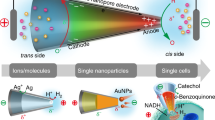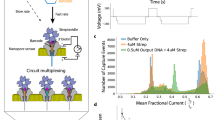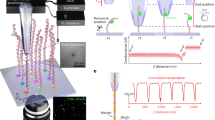Abstract
Nanopores could potentially be used to perform single-molecule DNA sequencing at low cost and with high throughput1,2,3,4. Although single base resolution and differentiation have been demonstrated with nanopores using ionic current measurements5,6,7, direct sequencing has not been achieved because of the difficulties in recording very small (∼pA) ionic currents at a bandwidth consistent with fast translocation speeds1,2,3. Here, we show that solid-state nanopores can be combined with silicon nanowire field-effect transistors to create sensors in which detection is localized and self-aligned at the nanopore. Well-defined field-effect transistor signals associated with DNA translocation are recorded when an ionic strength gradient is imposed across the nanopores. Measurements and modelling show that field-effect transistor signals are generated by highly localized changes in the electrical potential during DNA translocation, and that nanowire–nanopore sensors could enable large-scale integration with a high intrinsic bandwidth.
This is a preview of subscription content, access via your institution
Access options
Subscribe to this journal
Receive 12 print issues and online access
$259.00 per year
only $21.58 per issue
Buy this article
- Purchase on Springer Link
- Instant access to full article PDF
Prices may be subject to local taxes which are calculated during checkout




Similar content being viewed by others
References
Branton, D. et al. The potential and challenges of nanopore sequencing. Nature Biotechnol. 26, 1146–1153 (2008).
Venkatesan, B. M. & Bashir, R. Nanopore sensors for nucleic acid analysis. Nature Nanotech. 6, 615–624 (2011).
Zwolak, M. & Ventra, M. D. Colloquium: physical approaches to DNA sequencing and detection. Rev. Mod. Phys. 80, 141–163 (2008).
Dekker, C. Solid-state nanopores. Nature Nanotech. 2, 209–215 (2007).
Clarke, J. et al. Continuous base identification for single-molecule nanopore DNA sequencing. Nature Nanotech. 4, 265–270 (2009).
Derrington, I. M. et al. Nanopore DNA sequencing with MspA. Proc. Natl Acad. Sci. USA 107, 16060–16065 (2010).
Garaj, S. et al. Graphene as a subnanometre trans-electrode membrane. Nature 467, 190–193 (2010).
Merchant, C. A. et al. DNA translocation through graphene nanopores. Nano Lett. 10, 2915–2921 (2010).
Schneider, G. F. et al. DNA translocation through graphene nanopores. Nano Lett. 10, 3163–3167 (2010).
Fologea, D., Uplinger, J., Thomas, B., McNabb, D. S. & Li, J. Slowing DNA translocation in a solid-state nanopore. Nano Lett. 5, 1734–1737 (2005).
Peng, H. & Ling, X. S. Reverse DNA translocation through a solid-state nanopore by magnetic tweezers. Nanotechnology 20, 185101 (2009).
Olasagasti, F. et al. Replication of individual DNA molecules under electronic control using a protein nanopore. Nature Nanotech. 5, 798–806 (2010).
Luan, B. et al. Base-by-base ratcheting of single stranded DNA through a solid-state nanopore. Phys. Rev. Lett. 104, 238103 (2010).
Gracheva, M. E. et al. Simulation of the electric response of DNA translocation through a semiconductor nanopore-capacitor. Nanotechnology 17, 622–633 (2006).
King, G. M. & Golovchenko, J. A. Probing nanotube–nanopore interactions. Phys. Rev. Lett. 95, 216103 (2005).
Lagerqvist, J., Zwolak, M. & Ventra, M. D. Fast DNA sequencing via transverse electronic transport. Nano Lett. 6, 779–782 (2006).
Ivanov, A. P. et al. DNA tunnelling detector embedded in a nanopore. Nano Lett. 11, 279–285 (2011).
Chaste, J. et al. Single carbon nanotube transistor at GHz frequency. Nano Lett. 8, 525–528 (2008).
Hu, Y., Xiang, J., Liang, G., Yan, H. & Lieber, C. M. Sub-100 nanometer channel length Ge/Si nanowire transistors with potential for 2 THz switching speed. Nano Lett. 8, 925–930 (2008).
Cui, Y., Wei, Q., Park, H. & Lieber, C. M. Nanowire nanosensors for highly sensitive and selective detection of biological and chemical species. Science 293, 1289–1292 (2001).
Patolsky, F. et al. Electrical detection of single viruses. Proc. Natl Acad. Sci. USA 101, 14017–14022 (2004).
Patolsky, F. et al. Detection, stimulation, and inhibition of neuronal signals with high-density nanowire transistor arrays. Science 313, 1100–1104 (2006).
Kim, M. J., Wanunu, M., Bell, D. C. & Meller, A. Rapid fabrication of uniformly sized nanopores and nanopore arrays for parallel DNA analysis. Adv. Mater. 18, 3149–3153 (2006).
Kasianowicz, J. J., Brandin, E., Branton, D. & Deamer, D. W. Characterization of individual polynucleotide molecules using a membrane channel. Proc. Natl Acad. Sci. USA 93, 13770–13773 (1996).
Li, J. et al. Ion-beam sculpting at nanometre length scales. Nature 412, 166–169 (2001).
Cohen-Karni, T., Timko, B. P., Weiss, L. E. & Lieber, C. M. Flexible electrical recording from cells using nanowire transistor arrays. Proc. Natl Acad. Sci. USA 106, 7309–7313 (2009).
Tian, B. et al. Three-dimensional, flexible nanoscale field-effect transistors as localised bioprobes. Science 329, 831–834 (2010).
Osaki, T., Suzuki H., Le Pioutle, B. & Takeuchi, S. Multichannel simultaneous measurements of single-molecule translocation in α-hemolysin nanopore array. Anal. Chem. 81, 9866–9870 (2009).
Yan, H. et al. Programmable nanowire circuits for nanoprocessors. Nature 470, 240–244 (2011).
Cui, Y., Zhong, Z., Wang D., Wang, W. & Lieber, C. M. High performance silicon nanowire field effect transistors. Nano Lett. 3, 149–152 (2003).
Acknowledgements
The authors thank A. Meller, M. Wanunu, D. Casanova, J. Huang, J. Cahoon and T.J. Kempa for helpful discussions. C.M.L. acknowledges support of this work from a NIH Director's Pioneer Award (5DP1OD003900).
Author information
Authors and Affiliations
Contributions
P.X., Q.X., Y.F. and C.M.L. designed the experiments. P.X., Q.X. and Y.F. performed the experiments. P.X. performed the modelling and calculation. P.X. and Q.Q. wrote the program for data processing. P.X., Q.X., Y.F., Q.Q. and C.M.L. analysed the data and wrote the manuscript.
Corresponding author
Ethics declarations
Competing interests
The authors declare no competing financial interests.
Supplementary information
Supplementary information
Supplementary information (PDF 3498 kb)
Rights and permissions
About this article
Cite this article
Xie, P., Xiong, Q., Fang, Y. et al. Local electrical potential detection of DNA by nanowire–nanopore sensors. Nature Nanotech 7, 119–125 (2012). https://doi.org/10.1038/nnano.2011.217
Received:
Accepted:
Published:
Issue Date:
DOI: https://doi.org/10.1038/nnano.2011.217
This article is cited by
-
Not if but when nanopore protein sequencing meets single-cell proteomics
Nature Methods (2023)
-
Preparation and Magnetic Properties of Fe-Co–Ni Magnetic Nanowire Arrays with Three-Dimensional Periodic Structures
Journal of Superconductivity and Novel Magnetism (2023)
-
Localised solid-state nanopore fabrication via controlled breakdown using on-chip electrodes
Nano Research (2022)
-
Solid-state nanopore systems: from materials to applications
NPG Asia Materials (2021)
-
Single-molecule junction spontaneously restored by DNA zipper
Nature Communications (2021)



